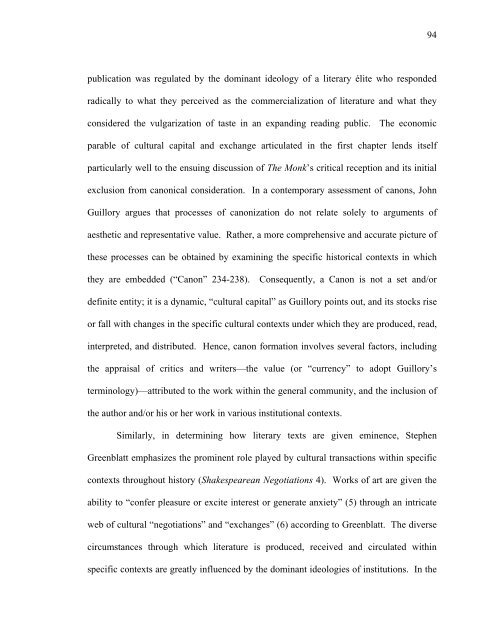Untitled - Sexey's School Moodle
Untitled - Sexey's School Moodle
Untitled - Sexey's School Moodle
You also want an ePaper? Increase the reach of your titles
YUMPU automatically turns print PDFs into web optimized ePapers that Google loves.
publication was regulated by the dominant ideology of a literary élite who responded<br />
radically to what they perceived as the commercialization of literature and what they<br />
considered the vulgarization of taste in an expanding reading public. The economic<br />
parable of cultural capital and exchange articulated in the first chapter lends itself<br />
particularly well to the ensuing discussion of The Monk’s critical reception and its initial<br />
exclusion from canonical consideration. In a contemporary assessment of canons, John<br />
Guillory argues that processes of canonization do not relate solely to arguments of<br />
aesthetic and representative value. Rather, a more comprehensive and accurate picture of<br />
these processes can be obtained by examining the specific historical contexts in which<br />
they are embedded (“Canon” 234-238). Consequently, a Canon is not a set and/or<br />
definite entity; it is a dynamic, “cultural capital” as Guillory points out, and its stocks rise<br />
or fall with changes in the specific cultural contexts under which they are produced, read,<br />
interpreted, and distributed. Hence, canon formation involves several factors, including<br />
the appraisal of critics and writers—the value (or “currency” to adopt Guillory’s<br />
terminology)—attributed to the work within the general community, and the inclusion of<br />
the author and/or his or her work in various institutional contexts.<br />
Similarly, in determining how literary texts are given eminence, Stephen<br />
Greenblatt emphasizes the prominent role played by cultural transactions within specific<br />
contexts throughout history (Shakespearean Negotiations 4). Works of art are given the<br />
ability to “confer pleasure or excite interest or generate anxiety” (5) through an intricate<br />
web of cultural “negotiations” and “exchanges” (6) according to Greenblatt. The diverse<br />
circumstances through which literature is produced, received and circulated within<br />
specific contexts are greatly influenced by the dominant ideologies of institutions. In the<br />
94



